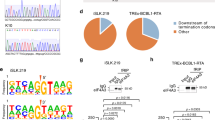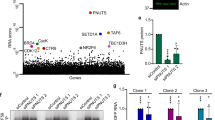Abstract
Kaposi's sarcoma–associated herpesvirus/human herpesvirus 8 (KSHV/HHV8) has been etiologically associated with several malignancies including Kaposi's sarcoma and primary effusion lymphoma. Oncogenic viral interferon regulatory factor (vIRF) encoded by KSHV ORF-K9 is a homologue of cellular interferon regulatory factor (IRF), and has been demonstrated to inhibit type I/II interferon signal transduction and transform NIH3T3 cells through the interactions with IRF-1, IRF-3, and CBP/p300 proteins. To counteract vIRF's pathogenic role, we have developed five ribozymes targeting ORF-K9 mRNA to suppress vIRF expression. The vIRF RNA substrates were cleaved up to 80% in a substrate-specific manner in transcript cleavage assays in vitro. In a transient transfection assay, two of the ribozymes efficiently suppressed the expression of vIRF protein measured by dual-color immunofluorescence assay that simultaneously detects the expression of both vIRF protein and ribozyme. Flow cytometry analysis showed that these ribozymes reduced vIRF expression up to 76%. A mutant ribozyme had no cleavage activity in vitro, but exhibited antisense effect in vivo. These results suggest that the ribozymes may provide a new approach for functional knockout of vIRF gene, and are potential candidates of antiviral therapy for KSHV-related malignancies. Cancer Gene Therapy (2001) 8, 285–293
This is a preview of subscription content, access via your institution
Access options
Subscribe to this journal
Receive 12 print issues and online access
$259.00 per year
only $21.58 per issue
Buy this article
- Purchase on Springer Link
- Instant access to full article PDF
Prices may be subject to local taxes which are calculated during checkout
Similar content being viewed by others
References
Schulz TF . Kaposi's sarcoma–associated herpesvirus (human herpesvirus-8) J Gen Virol 1998 79: 1573–1591
Gao SJ, Boshoff C, Jayachandra S, et al . KSHV ORF K9 (vIRF) is an oncogene which inhibits the interferon signaling pathway Oncogene 1997 15: 1979–1985
Zimring JC, Goodbourn S, Offermann MK . Human herpesvirus 8 encodes an interferon regulatory factor (IRF) homolog that represses IRF-1–mediated transcription J Virol 1998 72: 701–707
Li M, Lee H, Guo J, et al . Kaposi's sarcoma–associated herpesvirus viral interferon regulatory factor J Virol 1998 72: 5433–5440
Burysek L, Yeow WS, Lubyova B, et al . Functional analysis of human herpesvirus 8–encoded viral interferon regulatory factor 1 and its association with cellular interferon regulatory factors and p300 J Virol 1999 73: 7334–7342
Jayachandra S, Low KG, Thlick AE, et al . Three unrelated viral transforming proteins (vIRF, EBNA2, and E1A) induce the MYC oncogene through the interferon-responsive PRF element by using different transcription co-adaptors Proc Natl Acad Sci USA 1999 96: 11566–11571
Mamane Y, Heylbroeck C, Genin P, et al . Interferon regulatory factors: the next generation Gene 1999 237: 1–14
Chin YE, Kitagawa M, Su WC, et al . Cell growth arrest and induction of cyclin-dependent kinase inhibitor p21WAF1/CIP1 mediated by STAT1 Science 1996 272: 719–722
Dimri GP, Nakanishi M, Desprez PY, et al . Inhibition of E2F activity by the cyclin-dependent protein kinase inhibitor p21 in cells expressing or lacking a functional retinoblastoma protein Mol Cell Biol 1996 16: 2987–2997
Tanaka N, Ishihara M, Taniguchi T . Suppression of c-myc or fos B–induced cell transformation by the transcription factor IRF-1 Cancer Lett 1994 83: 191–196
Jonak GJ, Knight E Jr . Selective reduction of c-myc mRNA in Daudi cells by human beta interferon Proc Natl Acad Sci USA 1984 81: 1747–1750
James HA, Gibson I . The therapeutic potential of ribozymes Blood 1998 91: 371–382
Amado RG, Mitsuyasu RT, Symonds G, et al . A phase I trial of autologous CD34+ hematopoietic progenitor cells transduced with an anti-HIV ribozyme Hum Gene Ther 1999 10: 2255–2270
Wong-Staal F, Poeschla EM, Looney DJ . A controlled, Phase 1 clinical trial to evaluate the safety and effects in HIV-1–infected humans of autologous lymphocytes transduced with a ribozyme that cleaves HIV-1 RNA Hum Gene Ther 1998 9: 2407–2425
Funato T, Yoshida E, Jiao L, et al . The utility of an anti-fos ribozyme in reversing cisplatin resistance in human carcinomas Adv Enzyme Regul 1992 32: 195–209
Scanlon KJ, Jiao L, Funato T, et al . Ribozyme-mediated cleavage of c-fos mRNA reduces gene expression of DNA synthesis enzymes and metallothionein Proc Natl Acad Sci USA 1991 88: 10591–10595
Kashani-Sabet M, Funato T, Tone T, et al . Reversal of the malignant phenotype by an anti-ras ribozyme Antisense Res Dev 1992 2: 3–15
Funato T, Shitara T, Tone T, et al . Suppression of H-ras–mediated transformation in NIH3T3 cells by a ras ribozyme Biochem Pharmacol 1994 48: 1471–1475
Hua J, Muschel RJ . Inhibition of matrix metalloproteinase 9 expression by a ribozyme blocks metastasis in a rat sarcoma model system Cancer Res 1996 56: 5279–5284
Sehgal G, Hua J, Bernhard EJ, et al . Requirement for matrix metalloproteinase-9 (gelatinase B) expression in metastasis by murine prostate carcinoma Am J Pathol 1998 152: 591–596
Haseloff J, Gerlach WL . Simple RNA enzymes with new and highly specific endoribonuclease activities Nature 1988 334: 585–591
Mathews DH, Sabina J, Zuker M, et al . Expanded sequence dependence of thermodynamic parameters improves prediction of RNA secondary structure J Mol Biol 1999 288: 911–940
Cesarman E, Moore PS, Rao PH, et al . In vitro establishment and characterization of two acquired immunodeficiency syndrome–related lymphoma cell lines (BC-1 and BC-2) containing Kaposi's sarcoma–associated herpesvirus-like (KSHV) DNA sequences Blood 1995 86: 2708–2714
Chen S, Song CS, Lavrovsky Y, et al . Catalytic cleavage of the androgen receptor messenger RNA and functional inhibition of androgen receptor activity by a hammerhead ribozyme Mol Endocrinol 1998 12: 1558–1566
Halatsch ME, Schmidt U, Botefur IC, et al . Marked inhibition of glioblastoma target cell tumorigenicity in vitro by retrovirus-mediated transfer of a hairpin ribozyme against deletion-mutant epidermal growth factor receptor messenger RNA J Neurosurg 2000 92: 297–305
Abounader R, Ranganathan S, Lal B, et al . Reversion of human glioblastoma malignancy by U1 small nuclear RNA/ribozyme targeting of scatter factor/hepatocyte growth factor and c-met expression J Natl Cancer Inst 1999 91: 1548–1556
Tsuchida T, Kijima H, Oshika Y, et al . Hammerhead ribozyme specifically inhibits mutant K-ras mRNA of human pancreatic cancer cells Biochem Biophys Res Commun 1998 253: 368–373
Lo KM, Biasolo MA, Dehni G, et al . Inhibition of replication of HIV-1 by retroviral vectors expressing tat-antisense and anti-tat ribozyme RNA Virology 1992 190: 176–183
Irie A, Anderegg B, Kashani-Sabet M, et al . Therapeutic efficacy of an adenovirus-mediated anti–H-ras ribozyme in experimental bladder cancer Antisense Nucleic Acid Drug Dev 1999 9: 341–349
Yamazaki H, Kijima H, Ohnishi Y, et al . Inhibition of tumor growth by ribozyme-mediated suppression of aberrant epidermal growth factor receptor gene expression J Natl Cancer Inst 1998 90: 581–587
Seo T, Lee D, Lee B, et al . Viral interferon regulatory factor 1 of Kaposi's sarcoma–associated herpesvirus (human herpesvirus 8) binds to, and inhibits transactivation of, CREB-binding protein Biochem Biophys Res Commun 2000 270: 23–27
Acknowledgements
We thank Dr. Arun K. Roy for his kind suggestions. This work was supported, in part, by the Howard Hughes Medical Institute through the University of Texas Health Science Center at San Antonio for the Research Resources Program for Medical Schools S/G 7, Elsa U. Pardee Foundation, Association for International Cancer Research, and NIH Grant HL60604-01 to S.-J. Gao.
Author information
Authors and Affiliations
Corresponding author
Rights and permissions
About this article
Cite this article
Zhang, YJ., Wang, XP., Deng, JH. et al. Suppression of oncogenic viral interferon regulatory factor (vIRF) of Kaposi's sarcoma–associated herpesvirus by ribozyme-mediated cleavage. Cancer Gene Ther 8, 285–293 (2001). https://doi.org/10.1038/sj.cgt.7700299
Published:
Issue Date:
DOI: https://doi.org/10.1038/sj.cgt.7700299



